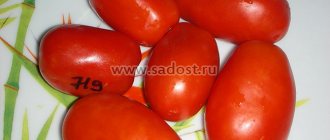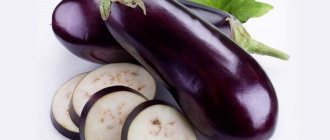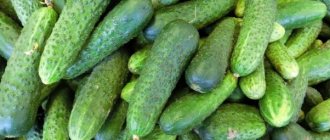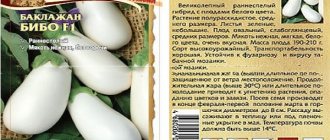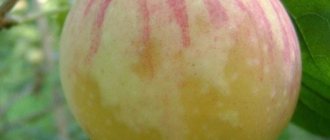Eggplant Bourgeois F1 is a promising hybrid, which is created on the basis of several productive species. This eggplant successfully combines large fruit, resistance to bad weather, resistance to frost, and tolerance of high humidity during the rainy season. The highlight of the hybrid is its interesting round shape (the fruits look like balls).
| Origin | Landing location | Ripening period | Fruit color | Fruit weight | Fruit shape |
| Hybrid | Greenhouse | Early ripening | Dark purple | 300 g. | Round |
History of growing eggplant Bourgeois F1
The hybrid was bred by a well-known seed breeding company founded in 1995. An application for state variety testing was submitted in 2005, and the variety was included in the State Register of Breeding Achievements of the Russian Federation in 2007. It is recommended for cultivation in open ground and under film covers in private farms in all regions of Russia. Since eggplant is one of the most heat-loving crops, the first option is only possible in the southern latitudes or central regions of our country with a milder climate.
Eggplant Bourgeois F1 bred by specialists
Cooking tips
Eggplants Bourgeois F1 are suitable for various culinary purposes. They are used in the preparation of first and second courses, appetizers, salads, and for stuffing. They can be fried, stewed, boiled, steamed, baked in the oven or grilled.
The pulp does not lose its taste and beneficial properties after heat treatment. Among the variety of dishes that can be prepared from eggplants, we should highlight caviar, stews, rolls, moussaka, lasagne, cutlets, and ratatouille.
These little blue ones should be grown by those who do winter harvesting. Canning will allow you to preserve the product for a long time. You can also freeze vegetables to preserve them for the winter. For freezing, the blue ones are cut into rings.
Did you know? Europeans learned about the existence of eggplant in the middle of the 15th century, but they began to use it in cooking only after 4 centuries.
When preparing eggplant dishes, you can use the following simple tips:
- Since vegetables contain a substance called solanine, which can add bitterness to a dish, to remove it, you should soak the blue ones in water for 20–30 minutes before cooking.
- Soaking chopped and salted vegetables for 25–30 minutes will also help eliminate bitterness. The water will need to be drained.
- To prevent the pulp from turning black, you must use stainless steel knives when cutting.
- The flesh will not turn black if you cook eggplants over high heat.
- Since eggplants quickly and actively absorb vegetable oil, so that they do not become too fatty during frying, it is necessary to cook them in a non-stick frying pan with the addition of a small amount of oil. When frying, roll vegetables in flour mixed with salt.
- For an original taste, you should combine blueberries with garlic, cilantro, and nuts.
Thus, the eggplant Bourgeois F1, thanks to the original shape of the fruit, is gaining more and more popularity. To grow it, you will have to put in a lot of effort. However, with proper care, the little blue ones will undoubtedly delight you with rich and tasty harvests.
Varietal characteristics and appearance of the variety
The plant is semi-spreading, not very tall (up to 70–80 cm), powerful, with a strong, slightly pubescent stem with an intense purple color. The medium-sized green leaves have a slightly wavy, rough surface and grooved edges. The leaf veins have traces of dark purple pigmentation. Large pale pink flowers with a purple tint are formed on a thick short stalk. The calyx is not spinous or has very sparse spines.
The fruit has the following characteristics:
- weight - 300 g (according to the State Register of Breeding Achievements of the Russian Federation) or 400–500 g (according to the originator);
- diameter with a mass of 300 g - 10 cm;
- the surface is glossy, may be slightly ribbed;
- color dark purple.
The fruits of the Bourgeois eggplant grow quite large, have an original spherical shape and a dark purple color.
Some gardeners note that there are specimens of Bourgeois F1 weighing 800 g.
The pulp is dense and at the same time tender, white or greenish in color, not bitter, with a subtle mushroom aroma. Eggplants store well and withstand transportation. The State Register of Breeding Achievements of the Russian Federation, the originator and gardeners evaluate the taste qualities as high.
An important nuance is the timely collection of eggplants: when overripe, the seeds become hard.
The fruits are used universally:
- boiled
- fry,
- baked
- stuffed
- grilled,
- pickled,
- canned,
- They even eat it raw.
The Bourgeois eggplant variety has dense, white flesh with a greenish tint when cut
Bourgeois is an early ripening hybrid (105–110 days pass from the moment of full shoots to the start of fruiting). The yield of the harvest can last up to one and a half months. The yield in the State Register of Breeding Achievements of the Russian Federation is indicated as 4.7 kg/m2, but there is no clarification regarding which method of cultivation. According to some data, this is an indicator of productivity when grown in open ground: there is information that up to 6 kg/m2 of fruit can be collected under film covers.
The State Register and the originator do not mention immunity. Other sources contain information about resistance to major crop diseases, and in them the variety is characterized as relatively unpretentious.
Advantages and disadvantages of the Bourgeois variety
The hybrid has a number of advantages:
- early ripeness;
- large fruit;
- the possibility of growing in open ground: this property is especially valuable for summer residents who do not have greenhouses;
Eggplant Bourgeois F1 gives a good harvest when grown without a greenhouse
- almost complete absence of thorniness;
- attractive presentation of fruits of unusual spherical shape;
- excellent taste;
- suitability for all types of processing and preparation of any dishes;
- extended harvest period.
The variety also has disadvantages, but they are much smaller:
- seeds germinate slowly;
- if the fruits are not harvested in a timely manner, the seeds become hard;
- You cannot collect your own seed (as with any other hybrid).
Description of preparation:
Of course, there are a lot of excellent recipes in Russian cuisine, but it’s still possible and even necessary to try foreign dishes, because sometimes you come across real masterpieces there. And since the vegetable season is now in full swing, I want to tell you about one very good and fairly simple recipe for Afghan eggplants. This dish is incredibly tasty, and thanks to the abundance of vegetables, it is very juicy, and it is also so easy to prepare that any housewife can handle it without much difficulty. For example, I very often delight my family with this delicacy and cook Afghan-style eggplants at home every summer, try it too. Purpose: For lunch / For dinner Main ingredient: Vegetables / Eggplant Dish: Hot dishes
Features of Bourgeois and differences from other spherical varieties of eggplant
The distinctive features of the Bourgeois F1 eggplant are the successful combination of early ripeness, large fruit and excellent taste, as well as the unusual shape of the fruit.
Bourgeois is not the only eggplant that has spherical fruits. Such varieties are not separated into a separate group, but it is still worth comparing their characteristics so that you can make the right choice.
Table: comparative characteristics of eggplants with spherical fruits
| Variety | Ripening time | Productivity, kg/m2 | Fruit weight, g | Taste | Cultivation method | Growing region |
| Bourgeois F1 | Early ripening, 105–110 days | 4,7 | From 300 | Great |
| All regions |
| Piglet | 108 days | 5.3 (under film covers) | 315 | Under film covers | ||
| Fat gentleman | Early ripening | 5.2–5.5 (under film covers) | 200–250 |
| ||
| globe | Mid-early | 2.8 (under film covers) | 837 | |||
| Master-master | Early ripening | 4.5 (under film covers) | 300 | Good | ||
| Purple ball | Early ripening | 350–400 | Great | |||
| Globular | Mid-season | 4.5–6.4 (under film covers) | 600–700 | Good |
Photo gallery: some spherical varieties of eggplants
Eggplant Master Master is suitable for any growing conditions
The Globe eggplant has a perfectly round shape.
The eggplant fruit Purple ball reaches a weight of 400 g
Storage
The harvest begins at the end of August and September. Pick the fruits on time, do not overexpose. They are picked with a stalk of about 5 cm. Eggplants are not stored for a long time, but can be stored in a dark, cool place at a temperature of 2 degrees for 4-6 weeks. The best place for storage is on a refrigerator shelf.
We wrote in more detail about ways to store eggplants here, and here you will learn how to properly freeze this vegetable for a long time.
Growing eggplants requires patience, but is fun. Choose the variety you like, provide proper care during growth, and you will be pleased with a rich harvest of round eggplants.
Landing nuances
The hybrid is cultivated by seedlings. The seed material, according to reviews, does not have a high germination rate and germination rate - it can take from one and a half to two weeks for the emergence of seedlings.
If the seeds have not been treated by the manufacturer, they should be soaked in one of the growth stimulants: Epin, Zircon, Ecogel.
After the emergence of seedlings, the seedlings develop within 60–65 days. It is easy to calculate that from the moment of sowing it will take up to 80 days to grow seedlings. The rules for growing planting material are standard.
To plant in beds, eggplant seedlings must be 80 days old
In the middle zone, seeds are sown for seedlings in the first half of March. Seedlings are planted in the garden bed depending on the cultivation method:
- in open ground in central Russia - at the end of May or the first half of June, when the soil warms up to +18 °C. Fruiting in this case will begin at the end of July and will continue throughout August;
- for unprotected beds in warm southern regions - in mid-May;
- into the greenhouse - starting in mid-May.
Accordingly, the timing of sowing seedlings is adjusted, subtracting 80 days from the expected date of planting in a permanent place.
The planting density of medium-sized semi-spreading bushes is no more than three per 1 m2. It is recommended to leave row spacing at least 60–70 cm, the distance in the row is 40–50 cm.
When planting in a garden bed, maintain a distance of 40–50 cm between eggplant bushes and 60–70 cm between rows; it is convenient to plant seedlings in a checkerboard pattern to save space.
In the southern regions, direct sowing in open ground is possible - in this case, the bed is covered with film to create comfortable conditions for seed germination. However, when growing Bourgeois in seedlings, the result will be better.
Features of plant care
When the main stem grows to 35 cm, pinch the top and leave 3-4 strong shoots, and cut the rest to the growth point. Strong, stable bushes can do without a garter, but if large fruits are formed, the stem may not withstand their weight: in this case, the plants will need supports. The harvest load is normalized:
- in open ground, it is recommended to leave no more than 5–6 fruits on the bush, otherwise they will be small;
- in a greenhouse, up to 10 full-fledged “bourgeoisies” can ripen on one plant.
In dry, hot weather, plants are watered every other day; at moderate temperatures, the frequency of watering is reduced to 1–2 times a week. They focus on the condition of the soil: it should be moist and loose, but not swampy.
It is better to feed with complex fertilizers. It should be remembered that eggplants need nitrogen only at the beginning of growth. During the formation of ovaries and during fruiting, phosphorus and potassium are added.
Beginning gardeners can use a complex fertilizer for eggplants: during flowering and fruit set, dry fertilizer is applied to moist soil (10 g per 1 square meter) and embedded deep
Other components of care are usual:
- shallow loosening of the soil;
- mulching with organic materials (peat, rotted sawdust, straw, etc.);
- weed control.
Reviews from experienced gardeners
Reviews about eggplant Bourgeois are mostly positive .
However, sometimes there are neutral or negative comments. Victoria, Saratov: “I planted Bourgeois eggplant last year.
The manufacturer's promises coincided with the result. The hybrid does not require much attention and is resistant to sudden climate changes. The taste of the fruit is soft and not bitter.” Olga, Moscow: “The bushes grew up to 1.5 m, after a month I tied them to a support. The fruits set well, the yield was excellent. Fertilized with liquid manure and ammonium nitrate. I used it to prepare baked dishes and stuffed them with meat filling.”
Igor, Orel: “The eggplant Bourgeois attracted me with its round fruits. I planted it in a greenhouse and expected to get large vegetables. However, the maximum weight of the fruit reached only 300 g. I looked after it regularly; I don’t know the reason for the meager harvest. Maybe it's the soil."


